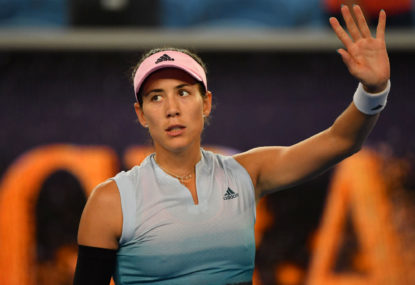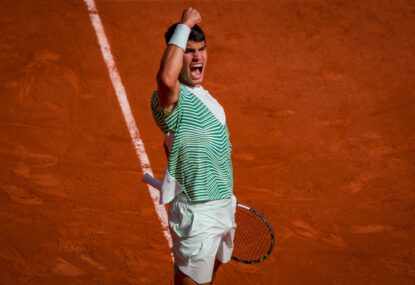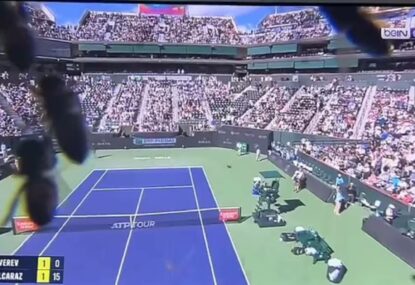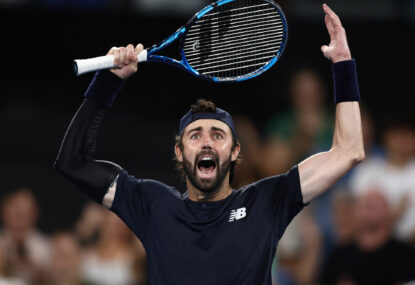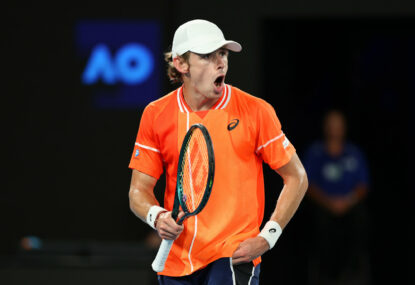And then there were two. For the fourth time in the past six years, Novak Djokovic and Andy Murray will bring down the curtain on another Australian Open when they clash in Sunday night’s men’s final.
Over the past fortnight, both players have shown why they are clearly the world’s top two men, with Djokovic picking up where he left off from his dominant 2015 season and Murray carrying the momentum from Great Britain’s drought-breaking Davis Cup victory into the new year.
World number one Djokovic arrived Down Under fresh off thrashing Rafael Nadal for the loss of just three games to win the title in Doha, and many expected that he would romp through the early rounds with ridiculous ease.
However, the first cracks started appearing as early as the second round when he was taken to third set tiebreaks by qualifier Quentin Halys and Andreas Seppi in the second and third rounds respectively.
Then, he was taken to five sets by Frenchman Gilles Simon in a match where he committed a whopping 100 unforced errors, before returning to his best in the quarter-final against Kei Nishikori which he won in straight sets.
That was then followed by the much-anticipated semi-final showdown against Roger Federer, against whom Djokovic was tied at 22 wins apiece in the head-to-head entering that match.
The Djoker appeared on track for his fourth straight-sets win against Federer at Grand Slam level when he took the opening two sets with ease, before the Swiss Maestro pegged a set back, leaving the Serb to settle for a four-set victory which saw him take the lead in his head-to-head against his Swiss rival for the first time.
That has qualified Djokovic for his sixth Australian Open final, and his 19th Grand Slam final overall, where he will face second seed Andy Murray who after four previously unsuccessful attempts at Melbourne Park will desperately be hoping that it’s fifth time lucky.
The Scot arrived Down Under with a massive cloud hanging over his head, having announced that he would withdraw mid-tournament if his wife, Kim Sears, was to go into labour back home in the United Kingdom earlier than anticipated.
However, the Scot hasn’t allowed that to become a distraction as he continued to display top form at Melbourne Park, despite his growing inability to win the title, as he has since first reaching the final in 2010.
In the first two rounds, he made a mockery of what was expected to be tough matches against Alexander Zverev and Sam Groth, defeating them both in straight sets and losing no more than four games in a set against them.
His first real test came in the third round when he faced Joao Sousa, despite the fact the Scot was undefeated against him in six previous meetings, including at last year’s Australian Open as well as in 2013.
Still, he won in four sets to reach the last sixteen for the eighth consecutive year, where he then maintained his perfect record against Australians when he defeated Bernard Tomic in straight sets to reach the quarter-finals.
Eighth seed David Ferrer was next to fall victim to the world number two, with the Scot winning in four sets to march onto the semi-finals where he then went up against Canadian 13th seed Milos Raonic, who had taken out 2014 champion Stan Wawrinka in five sets in the fourth round.
This was to be Murray’s toughest test yet, as the pair were tied 3-all in their head-to-head. Rather unsurprisingly, their semi-final went to five sets, and Murray appeared to be on his way out when he fell two sets to one down on Friday night.
However, the second seed would rally in the fourth set, taking it 6-4 after establishing the crucial break in the ninth game, before running away with it in the deciding set, taking it 6-2.
Now, Murray will attempt to avoid becoming the first man to lose five Australian Open finals when he comes up against Novak Djokovic, who conversely is undefeated in five previous finals at Melbourne Park, on Sunday night.
It will be the 31st time the two same-age rivals have met, with Djokovic leading 21-9. In fact, Djokovic has won ten of the last eleven meetings between the pair, dating back to Murray’s win at Wimbledon in 2013.
In similar nature to how Serena Williams hasn’t forgotten her loss to Maria Sharapova in the Wimbledon final in 2004, Djokovic certainly hasn’t forgotten that defeat, which allowed Murray to become the first British winner at the All England Club since Fred Perry in 1936.
The Scot did, however, win the Rogers Cup in Montreal last year at the Djoker’s expense; it is his only victory against his younger rival since that aforementioned Wimbledon final two-and-a-half years ago.
And so, the stage is set for what should be a cracker of a final between the world’s top two men. Here is everything you need to know heading into the men’s final on Sunday night.
Novak Djokovic (1) versus Andy Murray (2)
Sunday, January 31st
Not before 7:30pm
Rod Laver Arena
Head-to-head
All matches: Djokovic 21-9
At Grand Slams: Djokovic 6-2
At the Australian Open: Djokovic 4-0
In Grand Slam finals: Djokovic 3-2
In all finals: Djokovic 7-6
Last meeting: Djokovic defeated Murray 6-2, 6-4, final, 2015 Paris Masters
Novak Djokovic’s road to the final
Round 1: defeated Chung Hyeon 6-3, 6-2, 6-5
Round 2: defeated Quentin Halys 6-1, 6-2, 7-6 (7-3)
Round 3: defeated Andreas Seppi (28) 6-1, 7-5, 7-6 (8-6)
Round 4: defeated Gilles Simon (14) 6-3, 6-7 (1-7), 6-4, 4-6, 6-3
Quarter-finals: defeated Kei Nishikori (7) 6-3, 6-2, 6-4
Semi-finals: defeated Roger Federer (3) 6-1, 6-2, 3-6, 6-3
Andy Murray’s road to the final
Round 1: defeated Alexander Zverev 6-1, 6-2 6-3
Round 2: defeated Sam Groth 6-0, 6-4, 6-1
Round 3: defeated Joao Sousa (32) 6-2, 3-6, 6-2, 6-2
Round 4: defeated Bernard Tomic (16) 6-4, 6-4 7-6 (7-4)
Quarter-finals: defeated David Ferrer (8) 6-3, 6-7 (5-7), 6-2, 6-3
Semi-finals: defeated Milos Raonic (13) 4-6, 7-5, 6-7 (4-7), 6-4, 6-2
Stats that matter
* This will be Novak Djokovic’s 19th Grand Slam final, while for Andy Murray this will be his eighth. It will be their sixth and fifth Australian Open finals respectively.
* Djokovic will be shooting for his eleventh Grand Slam title, Murray his third. The former will be aiming for a record sixth Australian Open title, the latter his first after four previous defeats, the last three to Djokovic (the other was to Federer in 2010).
* This will be their sixth Grand Slam final against each other, ninth Grand Slam meeting overall and fifth overall at the Australian Open. Djokovic leads these categories 3-2, 6-2 and 4-0 respectively.
* Both of Andy Murray’s Grand Slam titles (2012 US Open and Wimbledon 2013) have come at the expense of Novak Djokovic. This includes his most recent Grand Slam title at Wimbledon in 2013.
* This will be the third consecutive Grand Slam final featuring the world’s top two men (Djokovic and Federer at Wimbledon and the US Open last year), but the first in Australia since the famous final between Djokovic and Nadal in 2012.
* Regardless of the result, Novak Djokovic and Andy Murray will remain one and two in the world respectively when the rankings are updated on Monday; Federer and Wawrinka will remain at three and four respectively.
* If Djokovic wins, he will become the first man since himself in 2011-12 to hold the Wimbledon, US Open and Australian Open titles simultaneously. It would also see Rafael Nadal “win” the wooden spoon for finishing at the end of the tournament’s longest losing chain.^
^ – in tennis, a wooden spoon (or an anti-Grand Slam) is won by the player who, as explained just above, finishes at the end of the tournament’s longest losing chain. If Djokovic defeats Murray, then Nadal will win it as he lost to Fernando Verdasco in the first round, who then lost to Dudi Sela in the second round, who then lost to Andrey Kuznetsov in the third round, and vice versa until the final.
Prediction
Novak Djokovic in four sets.






























































































